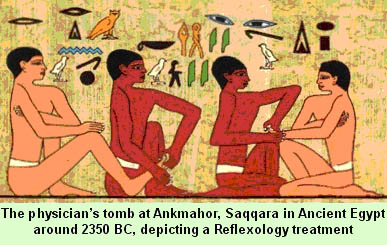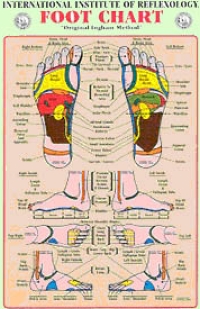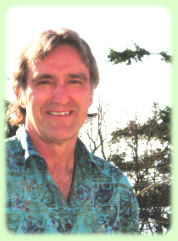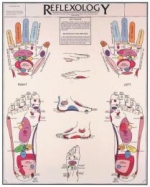 History of Reflexology
History of Reflexology
Reflexology has been rediscovered and reinstated as a health practice time and time again by peoples around the globe seeking to deal with health concerns. Archeological evidence in Egypt (2330 BCE), China (2704 BCE) and Japan (690 CE) points to ancient reflexology medical systems.
The origins of Reflexology evidently reach back to ancient Egypt as evidenced by inscriptions found in the physicians tomb at Saqqara in Egypt. The translation of the hieroglyphics is as follows: "Dont hurt me." The practitioners reply: - I shall act so you praise me. We cannot determine the exact relationship between the ancient art as practiced by the early Egyptians and Reflexology as we know it today. Different forms of working the feet to effect health have been used all over the ancient world. The practice of foot and hand manipulation in a variety of cultures and diverse belief systems throughout many historical periods lends strong speculation to the belief that reflexology has been used to aid healing throughout history as we know it.
The Zone Theory was the precursor to modern Reflexology. It started with William H. Fitzgerald, M.D. who published many articles he had written on the subject of Zone Analgesia. In a forward to a combined book by Dr. Fitzgerald and Edwin Bowers, M.D., "Relieving Pain At Home" published in, 1917, he wrote, "Humanity is awakening to the fact that sickness, in a large percentage of cases, is an error - of body and mind".
Dr. Fitzgerald was an Ear, Nose and Throat specialist at both the Boston City Hospital and St Francis Hospital in Connecticut. He called his work Zone Analgesia where pressure was applied to the corresponding bony eminence or to the zones corresponding to the location of the injury. He also used pressure points on the tongue, palate and the back of the pharynx wall in order to achieve the desired result of pain relief or analgesia. He made use of the following tools: elastic bands, clothes pegs and aluminum combs, on the hands, surgical clamps for the tongue, nasal probes and a regular palpebral retractor for the pharynx. Sometimes necessity is truly the master of invention.
Dr. Fitzgerald was responsible for formulating the first chart on the longitudinal zones of the body. He divided the body into ten vertical zones. These zones were alleged to correspond to the fingers and toes. He taught that bioelectrical energy flowed through these zones to reflex points in the hands and feet. His method of treatment involved the fastening of wire springs around toes.

Dr. Fitzgerald discovered that the application of pressure on the zones not only relieved pain but, in many cases, relieved the underlying cause as well. The same result is experienced through Reflexology today, which is based partially on the Zone Theory.
Shelby Riley, M.D. worked closely with Dr. Fitzgerald and developed the Zone Theory further. He added horizontal zones across the hands and feet and together with the longitudinal zones he determined individual reflexes according to the Zone Theory. He, like Fitzgerald, felt it necessary to apply continual pressure on the reflex point of contact.
 Eunice D. Ingham, a Physical Therapist, who worked closely with Dr. Riley, studied the concept of Zone Therapy and began to formulate her own foot reflex theory in the early 1930's.
Eunice D. Ingham, a Physical Therapist, who worked closely with Dr. Riley, studied the concept of Zone Therapy and began to formulate her own foot reflex theory in the early 1930's.
Blessed with the opportunity to treat hundreds of patients she mapped and documented each reflex point of contact carefully until she was able to determine that the reflexes on the feet were an exact mirror image of the organs of the body. This took many hours of checking and rechecking all her work to ensure her of the results she noted with full confidence. Her commitment and dedication to this process is outstanding achievement in the field of reflexology.
She wrote and had published " The Stories The Feet Can Tell" and is was at this point that the confusion between reflexology and zone therapy began. Her foreign publisher changed the name of the book to "Zone Therapy" and in some parts of the world reflexology is still thought of as zone therapy. However, there is a distinct difference between the two therapies. Zone therapy relies solely on the zones to determine the area to be worked, whereas reflexology takes the zones as well as the anatomical model to determine the area or areas to be worked.
In the late 50's Dwight Byers started helping Eunice Ingham at her workshops. In 1961 Dwight Byers and his sister Eusebia Messenger, RN joined their Aunt Eunice teaching at workshops on a full time basis. Seven years later they became responsible for the continued teaching of Reflexology under the banner of The National Institute of Reflexology. In the mid 70's Eusebia retired and Dwight Byers formed The International Institute of Reflexology, where the theories and techniques of Reflexology were further refined.







